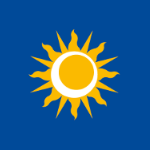Megelanese people
The Meᵹelaneſe (Italian: Meſiolaneſi) are the citizens of Meᵹelan, a country in northern Tyran, or people of Meᵹelaneſe ancestry. Legally, only people born and resident in Meᵹelan that can trace their direct ancestry to four Meᵹelaneſe grandparents (either citizens or subjects) are considered citizens of Meᵹelan, but people of Meᵹelaneſe ancestry can be found all over Tyran, especially in the areas between Cacerta and Gylias that used to constitute the polity of Alscia.
Today, there are 10,394,786 people of Meᵹelaneſe ancestry in Tyran: 4,237,301 of these live in Meᵹelan itself, while 6,157,485 of these live in the rest of Tyran; due to the devastation brought by the Meᵹelaneſe Civil War, there are less Meᵹelaneſe in Tyran today than there were in Meᵹelan alone in 1919. Due to high abortion, euthanasia and infanticide rates, the Meᵹelaneſe population's total fertility rate is quite low, if still above replacement level.
Ethno-linguistic composition
The ethno-linguistic composition of the territories of modern Meᵹelan includes the following components:
- The Western Lombard-speaking Meᵹelaneſe (38.8% of Meᵹelan's population) and the Eastern Lombard-speaking Meᵹelaneſe (23.7% of Meᵹelan's population) inhabit central Meᵹelan; their culture and language has been influenced the least by the polities surrounding Meᵹelan. They have been instead shaped by two distinct centers of power in Meᵹelan itself: Alba for the Western Lombard-speaking Meᵹelaneſe, and Vergate sul Membro for the Eastern Lombard-speaking Meᵹelaneſe.
- The Emilian-speaking Meᵹelaneſe (8.5% of Meᵹelan's population) inhabit the bogs and marshes of eastern Meᵹelan, and have traditionally been under heavy Cacertan influence, the Sofian creed having reached Meᵹelan through this region. They adopted agriculture only after the introduction of rice to Meᵹelan via Akashi, having engaged in nontaxable subsistence activities, such as swiddening and foraging, until then. The fertile nature of the soil of eastern Meᵹelan nonetheless allowed the Emilian-speaking Meᵹelaneſe to have the highest recorded population density of any known hunter and gatherer society in Tyran.
- The Ladin-speaking Meᵹelaneſe (6.0% of Meᵹelan's population) and the Walser-speaking Meᵹelaneſe (4.8% of Meᵹelan's population) inhabit the peaks and valleys of western Meᵹelan, and have traditionally been under heavy Delkoran influence, Vallyar having reached Meᵹelan through this region. The western Meᵹelaneſe states have been governed by political institutions based on direct democracy for as long as they have existed, and resistance to patrician oligarchy first and Futurist authoritarianism later was strongest there, to such an extent that western Meᵹelan did not fall to Futurist forces at any point during the Meᵹelaneſe Civil War.
- The Half-breed Meᵹelaneſe (18.2% of Meᵹelan's population) are a heterogeneous group of Meᵹelaneſe residents that includes people of Meᵹelaneſe descent that returned to Meᵹelan after the end of the Meᵹelaneſe Civil War, expatriates and immigrants from the rest of Tyran, people who left Meᵹelan and then returned later in life, as well as the children and descendants of all of these; their status as residents is evenly divided between aliens, subjects and citizens.
Italian, in its standard variety, is used by the entirety of the population of Meᵹelan as a lingua franca, while also being the official language of business, culture and politics. As speakers of Eastern Lombard, Emilian and Western Lombard make up the vast majority of Meᵹelan's population, these languages are official in the communes where they are spoken, alongside standard Italian; on the other hand, as Ladin and Walser are only spoken by small minorities in the western mountain ranges of the country, they are only official below the commune level - usually in civil parishes and villages deep in the valleys of western Meᵹelan - alongside standard Italian and at least one of the country's national languages.
Cultural history and national identity
The first known ancient inhabitants of the thick forests and swamps of prehistoric Meᵹelan belonged to an Indo-European people who, while being counted among the greatest producers of rock art in Tyran, began to turn the naturally marshy country they inhabited into flat, dry, low-lying agricultural land, through a system of drainage channels and man-made rivers; while genetic studies have indicated that there is a direct and unbroken link between the past and present inhabitants of Meᵹelan, little has survived of the original prehistoric culture, as the country fell under the cultural and linguistic influence of neighbouring polities, chiefly Cacerta and Delkora, quite early in its recorded history.
As a result of these influences, the inhabitants of the multiplicity of small, autonomous city-states that arose in Meᵹelan by the 10th century CE considered themselves ethnically or even racially separate, to such an extent that the Community of Meᵹelan was, at first, seen only as a military alliance, established to protect the rapidly expanding commerce of Meᵹelan's highly mobile and demographically expanding society. The unifying factors of the Meᵹelaneſe polities were chiefly religious and societal, as the near totality of the population adhered to Meᵹelaneſe traditional ƿitchcraft while taking part in a political system in which all decisions were made by communalism, with the city-states founded, governed and defended by cooperative decisions.
Only between the 19th and the 20th century, with the birth of romantic nationalism and the development of anthropology and genetics, the Meᵹelaneſe came to see themselves as inhabitants of a nation-state, and not just (as was the case earlier on in the history of Meᵹelan) as inhabitants of a consociational state based on a shared societal, religious and political outlook, even though, to this day, these two identities coexist without challenging or contradicting one another. Due to the extensive use of chemical weapons during the Meᵹelaneſe Civil War, the Meᵹelaneſe carry a large accumulation of genetic damage, which leads to fewer successful pregnancies and higher infant mortality; for the same reason, abortion, euthanasia and infanticide are accepted and widespread throughout the country. Template:Meᵹelan Navbox
